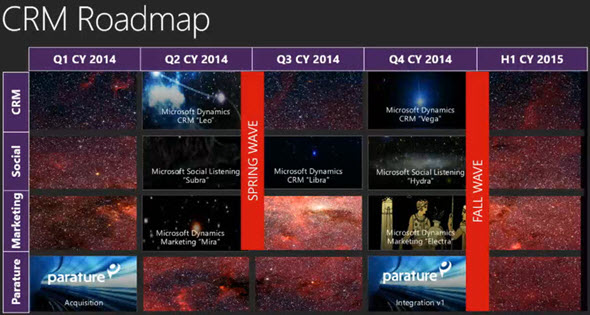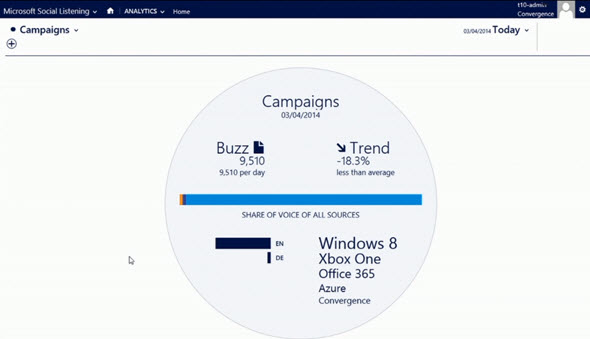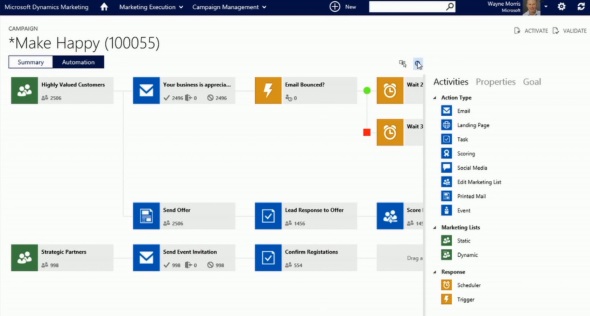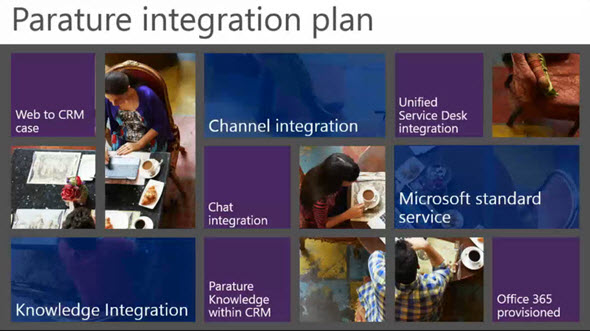Related sites:
Newsletter: Perspectives on Power Platform
Company: Niiranen Advisory Oy
The annual festivities of the Microsoft Dynamics Convergence event in the US have now been completed for the year 2014. This means that the outline for upcoming releases in this calendar year have also been presented to the 12K attendees in Atlanta as well as anyone watching the sessions via Virtual Convergence. The following roadmap slide shown at the event tells us the big picture: it’s going to be a busy year for Dynamics CRM!

OK, so if the first “swim lane” in the CRM Roadmap schedule is titled “CRM”, then what’s with all the other lanes then and how do these non-CRM items relate to the Dynamics CRM roadmap? Well, here’s the thing: this ain’t the CRM you used to know. It’s no longer that IIS application you used to install on your own little Windows server along with a SQL database and maybe a client component in Outlook. It’s now a suite of services that cover not just your internal processes and tools for your employees but also a wealth of external touch points where your customers will also encounter your CRM system, be it directly or indirectly. Oh, and naturally most of it lives in the cloud, because that’s also where your customers are.
Of course customer relationship management has never been about just that single CRM database where you keep your own contact records, but now it has become very obvious that also Microsoft’s offering in the field of CRM has grown way beyond that. Following on the footsteps of Oracle and Salesforce.com, the acquisition and integration of a growing number of tools to complement the traditional core Dynamics CRM platform means the future CRM product will be much more modular, as opposed to the earlier “one app & license for everybody” approach. Let’s go through each of these lanes in the CRM roadmap and look at what was announced for them at Convergence 2014, starting from the most familiar one: “CRM”.
After last fall’s release of the new Dynamics CRM 2013 major version (code name Orion), you might have been lead to believe that there wouldn’t be so much happening with the core platform this year, at least in the on-premises world. The earlier communication from Microsoft indicated that the plan was to introduce a new release for CRM Online twice a year and roll out an on-prem version once a year. The code names for these releases were also shared: Leo in Q2 2014 and Vega in Q4, one year after CRM 2013 RTM.
This is no longer true. But wait! It’s not an R8 style cancellation but rather a positive piece of news. The Q2 2014 release Leo will be for both CRM Online and on-premises customers, as will Vega. It doesn’t mean all the features will be identical across deployment models but it does promise to deliver new functionality also to customers who are running CRM on their own servers. What exactly will be the delivery mechanism (Update Rollups were supposed to be clear of any new features) or how the official naming convention for different versions will evolve is not yet clear, but currently Microsoft is referring to this as the Dynamics CRM Spring Wave. Partners will have a training blitz session for this wave on April 8th/9th, so expect to see more details made public after this.
The functional changes in Leo will focus on the service module of CRM. New features showcased in the Convergence sessions included SLA management with a timer control available on the case form, merging cases and linking parent/child cases, entitlement management, email to case automation and improvements in the queue feature usability. Considering how much these new features alter the case entity functionality and configuration options, it would have surely been quite difficult to continue supporting two different feature levels if Leo would have in fact been Online only. For callcenter scenarios the new Unified Service Desk (USD) will offer functionality similar to what has previously been delivered via components like the Customer Care Accelerator (CCA) or User Interface Integration (UII). Expect to see also other feature enhancements or tools released as a part of Leo that will not be customer service specific, as well as new capabilities for CRM Online subscription management.
The contents of the Vega release had not really been disclosed prior to Convergence 2014. As this release is still further away in the future the details are not yet as clear as for Leo, but a number of very interesting enhancements to the core Dynamics CRM product were shown on the CRM roadmap slides. Calculated fields will finally be available without writing custom code, via a graphical editor with intellisense support. Business Process Flows (BF) will be enhanced with support for branching processes. On the UI side we can expect to see built-in capability for visualizing account hierarchies. These three features all address very common scenarios that Dynamics CRM customers require in their system implementations, so it’s great to see them introduced as configurable features that a system customizer can leverage right out of the box.
Remember when Microsoft bought NetBreeze one year ago? Their service has now been integrated into the Redmond product portfolio and carries the name Microsoft Social Listening. Last month it was announced that Microsoft Social Listening will be offered as part of the CRM Online Professional licenses at no additional charge, whereas on-premises customers can get it for an incremental cost. This “incremental cost” was later specified to be $20 per user per month for CRM Professional CAL holders. So, while it’s not free for everyone, the pricing is still in line with Microsoft’s previous announcements of wanting to “democratize social” and integrate it as just another channel into their CRM product.
What can you do with Social Listening then? The examples shown at Convergence focused on measuring the social buzz around a set of keywords like “Convergence” and hashtags like #CONV14. The results can be embedded onto CRM dashboards as charts specific to the Social Listening feature, to give an understanding of how your brands or campaigns are performing in terms of both the volume of mentions as well as the sentiment of the messages being posted. The NetBreeze service has been migrated onto Azure and integrated with Office 365 provisioning. The application UI now follows the same patterns as Dynamics CRM itself, so the experience of jumping from CRM over to Social Listening to drill down on data or set up new search topics should be quite smooth.

In terms of other social tools, InsideView’s Social Insights add-on was featured in many occasions. If Social Listening is all about harvesting the bigger data sets on sentiments towards brands and topics, then Social Insights is aimed at profiling the individual contacts during a sales process, via sources like LinkedIn. Currently this service is bundled in with CRM Online Professional subscriptions only in the US, but plans for expanding to other markets was also on the roadmap. As for Yammer, I didn’t notice any mentions of planned improvements to the Dynamics CRM integration, but over at the SharePoint Conference in Las Vegas there must have been more buzz around the topic, due to new announcements like the Office Graph for Office 365.
Another recent Microsoft acquisition, Marketing Pilot, has also been re-branded and is now called simply Microsoft Dynamics Marketing. Similar to Social Listening, it looks like CRM in terms of the UI but is again a separate cloud application that synchronizes data with CRM. The feature set of Marketing Pilot has been further enhanced on the online and especially social channels, which now integrate more seamlessly with the campaigns. The reporting features leverage Power BI as the analytics delivery mechanism and can therefore produce impressive looking charts if you’ve entered all your budget and campaign activity data into Marketing Pi…, sorry, Dynamics Marketing. What’s by far the most visually impressive component of the new product version is the campaign workflow designer, which offers a drag & drop experience for configuring various activities, their sequence and conditions for defining automated nurture campaigns based on customer actions (or inactions).

Will this product be a built-in feature for CRM Online like Social Listening? In a way yes, but not with the existing Professional licenses. Microsoft has announced a new licensing tier called Dynamics CRM Enterprise, which is placed above the existing Essential, Basic and Professional tiers. And quite far above it in terms of cost, since a CRM Online Professional user license is $65/user/month and CRM Online Enterprise costs $200/user/month. In addition to Dynamics Marketing, also the Unified Service Desk component will be an enterprise-only feature. The detailed breakdown of features in each SKU (yes, even in the cloud era we still talk about stock keeping units for some peculiar reason) as well as on-premises pricing has not yet been disclosed, but the ability to mix & match different license types within an organization is likely to remain possible with Dynamics CRM (unlike with Salesforce), which means not every user will need to be upgraded to Enterprise to access these new apps.
With this pricing strategy, the Dynamics Marketing offering is not meant to replace Dynamics CRM’s native Marketing module anytime soon, but it is rather an extension towards a new segment of enterprise marketing teams who are currently using a whole set of different marketing automation and campaign management tools outside of CRM. The non-enterprise customer segments can continue using the existing marketing features of Dynamics CRM (campaigns, quick campaigns, marketing lists, campaign activities) and install third party solutions that integrate with these to perform HTML email campaign sending and tracking, web form integration and website visitor analytics. Since Dynamics Marketing is a separate application from CRM that lives in the cloud, support for the “marketing lite” features will most likely remain in Dynamics CRM for quite some time. The fact that the marketing module functionality is no longer included in the Dynamics CRM 2013 Applications certification exam MB2-700 does indicate that a more comprehensive marketing certification for CRM professionals is probably on its way, which may give us a better understanding of how Microsoft will align these two marketing applications in the future.
The final roadmap lane should logically say “service”, but since the acquisition of Parature is such a recent event compared to Marketing Pilot or NetBreeze, it has not yet been given a new brand from Microsoft. I’ve previously discussed in more detail why buying a service like Parature can help bringing customer service truly back to CRM and I wouldn’t be surprised at all to see a “Microsoft Dynamics Service” product launched at Convergence next year. For the time being, Parature is independent from Dynamics CRM, but the first Microsoft built integration is expected to appear before the end of the year. Items on the roadmap include the following integration points:

Microsoft is starting to bundle Parature in with CRM Online Enterprise subscriptions in US & Canada already but also continues to sell it as a standalone service. Similar to the marketing story, it’s unlikely that the case management functionality of the core Dynamics CRM platform would get removed and replaced with something from Parature (especially now when it’s being greatly enhanced in the Leo release). What Parature brings to the table is the ability to offer self-service channels to end customers and connect them with service reps via social tools that are closely integrated with CRM but not physically in CRM itself.
The addition of Social Listening, Dynamics Marketing and Parature grow the footprint of CRM quite significantly and allow the Dynamics team to reach out into new customer segments where they couldn’t have competed before. For existing customers and Dynamics CRM partners this can however make it somewhat more challenging to keep up with the development of the product and to understand which applications delivers which functionality. If you thought keeping up with the latest changes in CRM Update Rollups every couple of months was difficult, try tracking the 8 product releases that Microsoft has scheduled on their CRM roadmap for this year!
The way I see it, we’ve reached a turning point in the lifecycle of Dynamics CRM where it ceases to be a single application from the consultant’s point of view – yet at the same time the end users will see a more integrated solution covering their sales, marketing and service processes. There was one news article released with a title that nicely encapsulates the shift that is taking place: “Microsoft unifies almost everything in new Dynamics: CRM, marketing automation, social, and more”. With such a variety of services being offered under the same Dynamics umbrella, how can you anymore tell where CRM ends and another application begins?
To some extent the question is irrelevant. From the business perspective the goal of CRM has always been to deliver solutions that allow building the 360 view of the customer. From the user’s perspective the goal has been to deliver as seamless an experience as possible for carrying out the various actions needed to manage the relationship with this customer. Whether these goals are achieved via the Dynamics CRM application alone or a set of integrated apps isn’t really that important. However, the people in charge of designing these solutions need to be much more aware of the capabilities of all the applications included on the CRM roadmap and understand which components should be leveraged in each customer scenario. When their functionalities overlap and license costs differ based on the route chosen, it’s better to have a thorough understanding of what’s going on under the hood and how the data flows between the different cloud and on-premises applications.
As always, most of the important announcements and new features shown at Convergence were shared on Twitter in real time by active #MSDYNCRM community members attending the event in Atlanta. To capture some of this information for later viewing, I compiled three stories on Storify that showcase the most interesting tweets and pictures for the Dynamics CRM crowd from each main day of the event:
Don’t forget that you can also view recordings of most of the sessions by registering for Virtual Convergence.
Jukka, Your insight into what is happening with CRM is a big plus to everyone in the the MSDYNCRM community, please keep it up, and many congratulations on your recent MVP award. very well deserved.
Scott
Jukka, fantastic summary and detail from last week. Thanks for sharing!
Tony – CRMUG
[…] CRM MVP Jukkan shows us what delights CRM has lined up on its roadmap for 2014 http://jukkaniiranen.com/sandbox/2014/03/whats-2014-roadmap-microsoft-dynamics-crm/ […]
[…] services with those that a customer can deploy on their traditional servers. With the upcoming Leo release scheduled for Q2 2014 (the Dynamics CRM “Spring Wave” 2014) many people are expecting the support for […]
Thanks for sharing this roadmap, a great insight into what’s coming.
Just a small point though… in paragraph 7, did you mean we CAN expect to see built in capability for visualising account hierarchies? It currently reads we can’t.
Ah, I meant “can”, as the slide for complex organization support suggests. There is of course no certainty yet that all these features will make it to the Vega release, but I’ll remain hopeful that the account hierarchy visualization will be one of those.
Thank you for listing out all the updates of the Microsoft Dynamics CRM and for giving detailed summary about the product recent features …
Osm insights makes me think why I am stil using Microsoft Dynamics CRM as its one of the best CRM software out there! We need more blogs like these keep up the good work!
[…] CRM product in the Dynamics CRM portfolio. As we saw in the US Convergence event this spring, the product roadmap these days consists of four different lanes, with Dynamics Marketing, Social Listening and Parature […]
Get A Microsoft Social Listening Additional Posts Shared Server
[…] plication UI now follows the same patterns as Dynamics CRM itself, so the experi […]